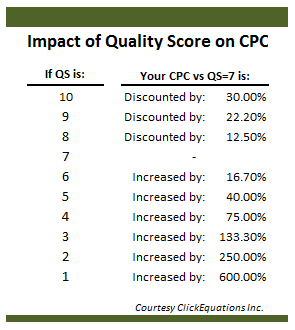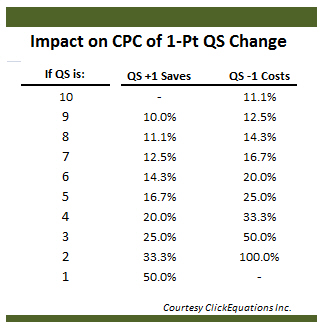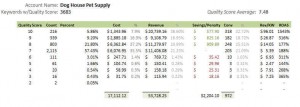In the paid search world, Quality Score is the new black. Blogs, forums, conferences, and Twitter are full of discussions of what quality score is and how you can optimize it.  But the real importance of quality score has been a bit hard to pin down. Not any more – we’re going to reveal the exact $$ value of quality score. UPDATE: Since this post was written, we’ve learned an important new fact about Quality Score – the numbers we’re shown are reported as integers between 1 and 10, but these are not the numbers or scale Google applies to in their formulas. Rather, they’re representative of the actual Quality Score in terms of 1 being poor and 10 being great. Knowing this, it seems unlikely the specific math and results described in this post are correct. The positive and negative effects of good and bad quality score remain true, and hopefully the numbers are roughly proportional. We’ll update this post further when we get more information. Why Does Quality Score Really Matter? The prominence of quality score has been based on it’s role in Ad Rank – the formula Google uses to determine the position in which your ad appears. Ad Rank = Bid x Quality Score. But Quality Score also plays a very important role in determining how much you’re charged per click. This is a separate application of the value which occurs after Ad Rank is calculated. The recently released Google Video by Google’s Chief Economist, Hal Varian helped clarify this point. In the video Mr. Varian points out that your cost-per-click is calculated using the formula: Ad Rank of the ad below yours / your quality score. So if you’re in position #1 with a quality score of 5, and the ad in position #2 has an Ad Rank of 10, your cost-per-click is 10/5 = $2. So What Is Quality Score Worth? Knowing this is how cost-per-click is calculated, we’re able to determine the specific impact of any quality score on your cost-per-click. And therefore the exact cost or savings from any single-digit increase or decrease in your quality score. Yes that’s right – we can tell you the specific change in your CPC that is due to the quality score you’re getting for each of your keywords. For example, your QS=10 keywords are enjoying a 30% CPC discount as compared to if they were QS=7 and in the same position. And your QS=4 keywords are paying a whopping 75% premium for their position. The table below contains the complete list. This details the positive or negative impact quality score is having on the CPC prices you’re paying. These factors are true regardless of your bid, position or those of your competitors. These are the impacts of Quality Score on your cost-per-click, anywhere, anytime.
But the real importance of quality score has been a bit hard to pin down. Not any more – we’re going to reveal the exact $$ value of quality score. UPDATE: Since this post was written, we’ve learned an important new fact about Quality Score – the numbers we’re shown are reported as integers between 1 and 10, but these are not the numbers or scale Google applies to in their formulas. Rather, they’re representative of the actual Quality Score in terms of 1 being poor and 10 being great. Knowing this, it seems unlikely the specific math and results described in this post are correct. The positive and negative effects of good and bad quality score remain true, and hopefully the numbers are roughly proportional. We’ll update this post further when we get more information. Why Does Quality Score Really Matter? The prominence of quality score has been based on it’s role in Ad Rank – the formula Google uses to determine the position in which your ad appears. Ad Rank = Bid x Quality Score. But Quality Score also plays a very important role in determining how much you’re charged per click. This is a separate application of the value which occurs after Ad Rank is calculated. The recently released Google Video by Google’s Chief Economist, Hal Varian helped clarify this point. In the video Mr. Varian points out that your cost-per-click is calculated using the formula: Ad Rank of the ad below yours / your quality score. So if you’re in position #1 with a quality score of 5, and the ad in position #2 has an Ad Rank of 10, your cost-per-click is 10/5 = $2. So What Is Quality Score Worth? Knowing this is how cost-per-click is calculated, we’re able to determine the specific impact of any quality score on your cost-per-click. And therefore the exact cost or savings from any single-digit increase or decrease in your quality score. Yes that’s right – we can tell you the specific change in your CPC that is due to the quality score you’re getting for each of your keywords. For example, your QS=10 keywords are enjoying a 30% CPC discount as compared to if they were QS=7 and in the same position. And your QS=4 keywords are paying a whopping 75% premium for their position. The table below contains the complete list. This details the positive or negative impact quality score is having on the CPC prices you’re paying. These factors are true regardless of your bid, position or those of your competitors. These are the impacts of Quality Score on your cost-per-click, anywhere, anytime.  As you can see, there are serious savings to be had with high quality scores (8, 9, or 10) and very high penalty costs to low quality scores (6 or below). How We Calculated These Numbers We calculated these values by comparing the impact of quality score on the price established at a wide range of Ad Rank values. This analysis showed that when QS was applied as the denominator of the equation, the Ad Rank values didn’t matter – the impact of each step of quality score was consistent. (Check out the raw data). So it was a simple task to compute percentage of impact each different QS had on CPC.
As you can see, there are serious savings to be had with high quality scores (8, 9, or 10) and very high penalty costs to low quality scores (6 or below). How We Calculated These Numbers We calculated these values by comparing the impact of quality score on the price established at a wide range of Ad Rank values. This analysis showed that when QS was applied as the denominator of the equation, the Ad Rank values didn’t matter – the impact of each step of quality score was consistent. (Check out the raw data). So it was a simple task to compute percentage of impact each different QS had on CPC.  Note that we set QS=7 as the neutral value because using ClickEquations to review a wide range of accounts we’ve seen that QS=7 appears to be the mean quality score across a very large and diverse set of keywords. In other words, most keywords get QS=7, that’s the typical score. So quality scores better than 7 can be considered better-than-average and thereby beneficial, and quality scores lower than 7 are lower-than-average and detrimental. Two Important Disclaimers 1) Since quality score is used to first compute the Ad Rank and then to influence the CPC, you wouldn’t actually have the position you do if you didn’t have that quality score. So it isn’t exactly accurate to say that your keyword is paying 30% less for position 1 at QS=10 than at QS=7, because in most cases you wouldn’t be at position 1 if you did have a QS=7. I think the relative value for each QS remains valid and valuable. 2) Google very likely calculates quality score not as an integer but as a real number (you your QS isn’t actually 6 but rather 6.329498) which means the impact would be more linear and not in the big steps the charts suggest. Thanks to commenters for pointing out that this fact was left out of the original post. What Does A 1-Point Change Cost You? Based on the same numbers, this next table documents the economic cost or benefit of having your quality score move up or down by 1 point.
Note that we set QS=7 as the neutral value because using ClickEquations to review a wide range of accounts we’ve seen that QS=7 appears to be the mean quality score across a very large and diverse set of keywords. In other words, most keywords get QS=7, that’s the typical score. So quality scores better than 7 can be considered better-than-average and thereby beneficial, and quality scores lower than 7 are lower-than-average and detrimental. Two Important Disclaimers 1) Since quality score is used to first compute the Ad Rank and then to influence the CPC, you wouldn’t actually have the position you do if you didn’t have that quality score. So it isn’t exactly accurate to say that your keyword is paying 30% less for position 1 at QS=10 than at QS=7, because in most cases you wouldn’t be at position 1 if you did have a QS=7. I think the relative value for each QS remains valid and valuable. 2) Google very likely calculates quality score not as an integer but as a real number (you your QS isn’t actually 6 but rather 6.329498) which means the impact would be more linear and not in the big steps the charts suggest. Thanks to commenters for pointing out that this fact was left out of the original post. What Does A 1-Point Change Cost You? Based on the same numbers, this next table documents the economic cost or benefit of having your quality score move up or down by 1 point.  As you can see, if your QS=9, then moving up 1 pt (to QS=10) will give you a 10% CPC discount. Starting from that same QS=9 and losing 1 pt (to QS=8) will result a 12.5% % CPC increase. A Clear New Reason To Improve Your Quality Score Knowing that your quality scores are saving you up to 30%, or costing you up to 133%, should further motivate everyone to both know and work to improve your quality scores. In ClickEquations we have a lot of features that can help you improve quality score:
As you can see, if your QS=9, then moving up 1 pt (to QS=10) will give you a 10% CPC discount. Starting from that same QS=9 and losing 1 pt (to QS=8) will result a 12.5% % CPC increase. A Clear New Reason To Improve Your Quality Score Knowing that your quality scores are saving you up to 30%, or costing you up to 133%, should further motivate everyone to both know and work to improve your quality scores. In ClickEquations we have a lot of features that can help you improve quality score:
- We list QS (and the related Min First Page Bid) right next to each keyword so you can watch them carefully.
- Our ClickShare metrics tell you which ad groups and keywords aren’t getting as many clicks as they should – and why – which can help you drive up CTR which is by far the largest driver of quality score.
- Our ClickVariance metric tells you when you’ve got keywords in ad groups which are under-performing based on CTR, so you can move them into their own groups and write more applicable ads, or pause/delete them – thereby driving up average CTR
- Our complete search query detailed reporting lets you add new keywords and phrases that users have proven that they click on
- Our multivariate text-ad testing tool is the best possible way to drive up CTR – often by 2X-5X which skyrockets quality score

Click To Enlarge
And A Warning One small word of caution regarding the existing, and likely to continue, flood of tips on improving quality score. Be very suspect of anything which promises to improve quality score by any method other than improving click-through-rate. Relevance has it’s place. But both the new Google Video and other recent disclosures make clear that CTR drives quality score. You will not have meaningful impact getting your keywords into your text-ads, grouping keywords in better ways, and many of the other tactics getting over-hyped in some quarters. Relevance plays a supporting role, as does landing page to an even lesser degree, but both are trumped and trounced by CTR. Get great CTRs and you’ll get great QS’s. There is no other route. Summary We hope you’re as excited as we are about the discovery of the true economic benefit and cost of quality score. Another small victory for transparency in the paid search process. Which means another tool to help us manage PPC in High Resolution.



